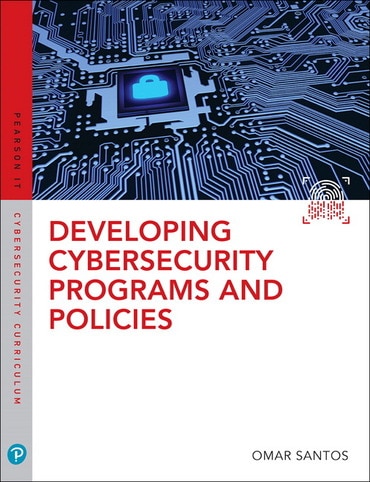
Developing Cybersecurity Programs and Policies, 3rd edition
Title overview
This book is a complete guide to establishing a cybersecurity program and governance in your organization. In this book, studentswill learn how to create cybersecurity policies, standards, procedures, guidelines, and plans — and the differences among them. This book covers the Confidentiality, Integrity & Availability (CIA) security model. Students will also learn how threat actors are launching attacks against their victims compromising confidentiality, integrity, and availability of systems and networks. This book covers the NIST Cybersecurity Framework and ISO/IEC 27000-series standards. Readers will learn how to align security with business strategy, as well as define, inventory, and classify information and systems.
This book teaches students how to systematically identify, prioritize, and manage cybersecurity risks and reduce social engineering (human) risks with role-based Security Education, Awareness, and Training (SETA). They will also learn how to implement effective physical, environmental, communications, and operational security; and effectively manage access control. In this book students will learn how to respond to incidents and ensure continuity of operations and how to comply with laws and regulations, including GLBA, HIPAA/HITECH, FISMA, state data security and notification rules, and PCI DSS.
-
The in-depth, up-to-the-minute guide to information security policy for every practitioner and advanced student
-
In-depth coverage of information security policy from definition, psychology, standard frameworks, and creating a culture of compliance
-
Thorough coverage of Security Education, Training & Awareness (SETA)
-
Appendices include: Employee Affirmation Statement and Resources for Security Professionals
Updated to cover the latest information in cybersecurity.
1. Updated to include “cybersecurity” (which expands the universe of information security). cross reference to ISO 27000 (current edition), ISO 27032:2012 Guidelines for Cybersecurity, NIST Cybersecurity Framework or alternately – not use cross references. The cross references drive the organization of the book.
2. If the book is going to be more cyber based, adding a chapter on Attacks and Attackers and the chapter on Incident Response is expanded
3. As applicable, newer technologies should be referenced (e.g. virtualization, DLP, NAC, Cloud, MDM)
4. Part 3 Regulatory Compliance (Chapters 13,14, 15) updated to reflect current regulatory expectations and contractual obligations.
5. FYI’s updated to reflect current examples.
6. All embedded examples reviewed to ensure they are still relevant.
7. All exercises and case studies reviewed to ensure they are still relevant.
8. The policies themselves will only need minor tweaking + any language specific to “cyber”.
Table of contents
- Chapter 1. Understanding Cybersecurity Policy and Governance
- Chapter 2. Cybersecurity Policy Organization, Format and Styles
- Chapter 3. Cybersecurity Framework
- Chapter 4. Governance and Risk Management
- Chapter 5. Asset Management and Data Loss Prevention
- Chapter 6. Human Resources Security
- Chapter 7. Physical and Environmental Security
- Chapter 8. Communications and Operations Security
- Chapter 9. Access Control Management
- Chapter 10. Information Systems Acquisition, Development, and Maintenance
- Chapter 11. Cybersecurity Incident Response
- Chapter 12. Business Continuity Management
- Chapter 13. Regulatory Compliance for Financial Institutions
- Chapter 14. Regulatory Compliance for the Healthcare Sector
- Chapter 15. PCI Compliance for Merchants
- Appendix A. Information Security Program Resources
- Appendix B. Sample Information Security Policy
- Appendix C. Information Systems Acceptable Use Agreement and Policy
Author bios
Omar Santos is a principal engineer in the Cisco Product Security Incident Response Team (PSIRT) within the Cisco Security Research and Operations. He mentors and leads engineers and incident managers during the investigation and resolution of security vulnerabilities in all Cisco products, including cloud services. Omar has been working with information technology and cybersecurity since the mid-1990s. Omar has designed, implemented, and supported numerous secure networks for Fortune 100 and 500 companies and the U.S. government. Prior to his current role, he was a technical leader within the World-Wide Security Practice and the Cisco Technical Assistance Center (TAC), where he taught, led, and mentored many engineers within both organizations.
Omar is an active member of the security community, where he leads several industrywide initiatives and standard bodies. His active role helps businesses, academic institutions, state and local law enforcement agencies, and other participants that are dedicated to increasing the security of the critical infrastructure.
Omar often delivers technical presentations at many conferences and to Cisco customers and partners. He is the author of dozens of books and video courses. You can follow Omar on any of the following:
Personal website: omarsantos.io
Twitter: @santosomar
LinkedIn: https://www.linkedin.com/in/santosomar